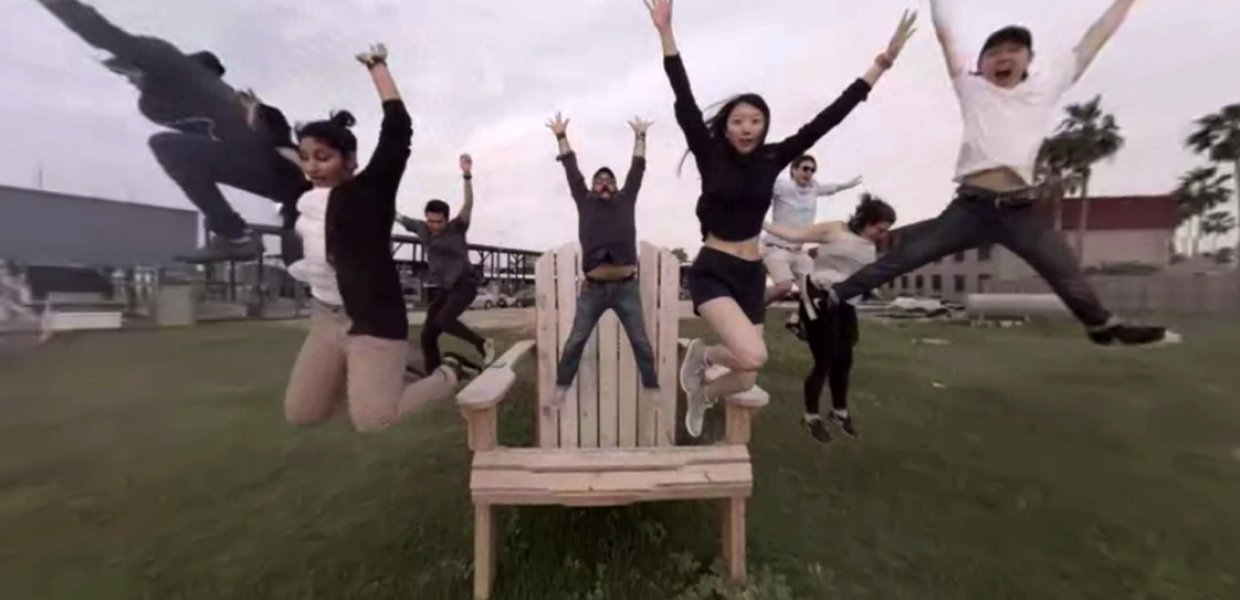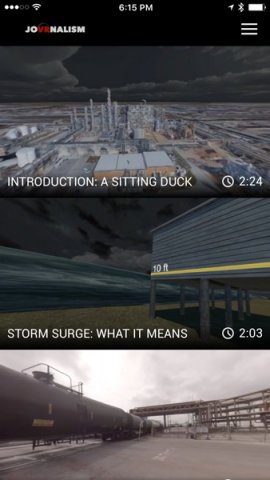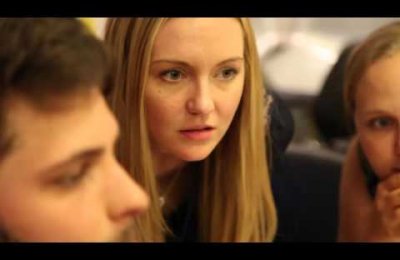Additional reporting by Yosuke Kitazawa.
Someday a perfect storm will hit the Gulf Coast city of Houston. We don’t know when it will arrive. But we do know that, when it finally does hit the country’s fourth largest city, it could result in thousands of lives lost, millions of dollars in damages and a paralyzed American economy—and little is being done to prepare for it.
This past spring, USC Annenberg professor of professional practice Robert Hernandez and a group of his students put their talents to work in hopes of changing that with the help of virtual reality (VR) journalism. Hernandez and his team travelled to Texas over spring break to work on an immersive VR piece to accompany “Hell and High Water,” a crucial investigative look at Houston’s vulnerabilities to hurricanes.
Produced by ProPublica and the Texas Tribune, “Hell and High Water” details the widespread destruction and catastrophic repercussions that could occur if a storm the size of 2008’s Hurricane Ike were to hit Houston. Visitors to their interactive story can read about the situation in Houston while running storm scenarios that visualize the effects of different surges on the city.
USC Annenberg’s unique contribution to the project was to deploy virtual reality tools and techniques to produce what Hernandez to take those experiences to the next level by immersing the audience directly in the story. He and his class produced this work under the name JOVRNALISM.
“Our goal is to put you there,” Hernandez said. “Our hope is for you to really see and feel what this storm could mean for Houston and for the rest of the country.”
Hernandez and his team joined the project after Scott Klein, deputy managing editor of ProPublica, approached him for advice on using immersive journalism to shed light on hurricane preparedness.
“One of the problems in raising awareness about hurricane dangers is that people have a hard time thinking about natural catastrophes when they’re not bearing down on them,” Klein said. “So we thought, with VR, we can help them see what it will be like to have a natural catastrophe bearing down on them. One thing led to another, and [Hernandez] developed a class to do some experiments and create the experiences.”

Hernandez and his crew of jovrnalists spent the the spring class time forging a unique VR classroom experience through hands-on experimentation and collaboration. As part of the course, the group flew to Houston this past March to put that classroom learning to a real world test. The entire project was made possible thanks to a string of strong partnerships between Hernandez and leading organizations, from the writers and editors at ProPublica and The Texas Tribune, to the Google News Lab and camera house Radiant Images, who both provided the team with their gear.
With seven GoPro camera rigs (six and seven cameras on a specific mount), a laptop and an array of peripheral devices in tow, the JOVRNALISM team captured a Houston that was previously unknown to them.
“It was like riding down the set of ‘Blade Runner’ in the daytime. There was fire and smoke stacks all around us,” said Kevin Tsukii (B.A., Print and Digital Journalism, ’16) of riding a boat down the Houston Ship Channel, one of the world’s busiest shipping lanes.
Like any intrepid news team, these jovrnalists jumped through all manner of unexpected hoops to get their story.
“We got cops called on us,” Hernandez said. “One guy started yelling at me because he thought I had a bomb (it was really the 360 camera). One of our GoPro cameras died. But the students produced more than I could have imagined.”
Footage from the trip was incorporated into their final virtual reality piece along with interviews of scientists, local leaders and residents. The students taught themselves new skills in order to put them all in place. “We figured out how to work the cameras, the stitching software, editing using Adobe Premiere, and using the SkyBox plugin,” said Kaitlyn Mullin (B.A. Digital Journalism ’16).
Ultimately, the goal of the project is to move people through not just a virtual Houston, but into the civic and political spaces where a coming disaster might still be averted.
“It’s an economic and an environmental disaster waiting to happen,” Hernandez said. ”You’ll be flying over Houston not just to get a pretty visual overview but a sense of how their areas relate to each other and why you should care.”
Explore the YouTube version of "Hell and High Water VR" below:
Hernandez recommends experiencing “Hell and High Water VR” in the JOVRNALISM app (for iOS and Android). The app gathers all the VR journalism work created so far by his students, including a 360-degree tour of Wallis Annenberg Hall, a VR portrait of the Angel City Derby Girls, and other immersive pieces which Hernandez describes as “experiences.”
“These were not full-fledged stories, but an independent collection of experiences with storytelling sprinkled inside,” Hernandez said. He describes those experiences as “phase one,” while “Hell and High Water VR” is on the cusp of phase two, which he sees as narrative feature storytelling in a VR environment.
“We're still all trying to figure out what makes good 360 immersive storytelling,” Hernandez said. “There's a lot of trial and error. The ProPublica piece, I think does a good job, but it's not truly a standalone piece because you should still read the text to really understand the nuances.”
The piece will also be published on Youtube, Facebook, SamsungVR, GoPro and the JOVRNALISM site. While Hernandez believes these platforms do not showcase the full capabilities of interactive VR, they are crucial to reaching the widest possible audience. After all, almost everyone owns a smartphone, but very few have access to expensive VR headsets.

USC has played an important role in the development of this latest wave of VR technology, especially its use in the field of journalism. Among the key players have been Nonny de la Pena, former Senior Research Fellow in immersive journalism at USC Annenberg, who has been called the “Godmother of Virtual Reality,” and Palmer Luckey, a journalism student from Cal State Long Beach who left his studies to develop the Oculus Rift while working at Institute for Creative Technologies’ MxR Lab at USC School of Cinematic Arts.
“Los Angeles is the epicenter of all things VR, from gaming to Hollywood to hopefully journalism—and the center of that epicenter is USC,” Hernandez said. “If you go to any VR meetup, USC is the dominant player there.”
For some JOVRNALISM team members, working in VR journalism has led to unique opportunities. Tsukii is now immersive video lead for de la Peña’s Emblematic Group, one of the world's leading producers of immersive virtual reality content. He said the experience was pivotal in his career. “It’s one of the most important classes I’ve taken at USC Annenberg,” Tsukii said. “While others are reacting to new technology, Professor Hernandez is in-step with the industry, experimenting with new technologies right now.”
Mullin was hired by The New York Times as one of the first video journalists to focus on VR.
Not only do students benefit from such work, but ultimately audiences will as well. “VR literally places the viewer into the scene,” Mullin said. “It’s immersive, impactful. We want to bring people back to being excited about the news.”
Hernandez, too, believes that VR could be an ideal platform for news and storytelling. ”Journalism has got an incredible role to play [in VR]. It takes time for VR video games and films to be made—what are you going to be doing with the Google cardboard or the Oculus if you're going to wait to consume stuff? I think journalists can tell stories quicker, and can really take advantage of that framework.”
The “Hell and High Water” VR experience has already garnered interest. Mullin published a lengthy technical overview of the project for Harvard’s Neiman Journalism Lab, and in August Hernandez and his JOVRNALISM class received the 2016 Creative Projects award from the Association for Education in Journalism and Mass Communication’s Visual Communication division.
Hernandez is proud of the role he and his students have played in shaping the world of VR journalism, and is optimistic about its future.
“With this piece, what's really special is that ProPublica recognized us and proactively approached us about doing their piece and collaborating with them to do an immersive experience,” Hernandez said. “That shows a lot of respect, and that we're making a dent in this industry.”
Development of the JOVRNALISM work was funded in part by a grant Hernandez received from the John S. and James L. Knight Foundation.








